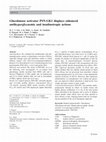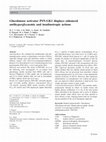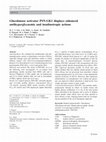Papers by Richard Chatfield

Diabetologia, 2007
Aims/hypothesis We evaluated the insulinotropic and antihyperglycaemic actions of glucokinase act... more Aims/hypothesis We evaluated the insulinotropic and antihyperglycaemic actions of glucokinase activators (GKAs), especially through acute and subchronic studies in rodent diabetes models with (2R)-2-(4-cyclopropanesulphonylphenyl)-N-(5-fluorothiazol-2-yl)-3-(tetrahydropyran-4-yl)propionamide (PSN-GK1), a novel and potent GKA. Materials and methods The action of PSN-GK1 on or in the following were investigated: (1) on human liver glucokinase, insulin secretion from MIN6 cells and 2-deoxy-d-[3H]glucose (2-DG) uptake into rat hepatocytes; and (2) in Zucker diabetic fatty rats and in non-diabetic C57Bl/6, diabetic db/db and ob/ob mice. Results At 5 mmol/l glucose, PSN-GK1 activated glucokinase (4.3-fold, median effective concentration [EC50] 130 nmol/l), increased MIN6 insulin secretion (26-fold, EC50 267 nmol/l) and 2-DG hepatocytic uptake (threefold, EC50 1 μmol/l); at higher glucose concentrations, EC50s and fold-effectiveness were both lower. In C57Bl/6 mice, PSN-GK1 reduced blood glucose at 1 and 10 mg/kg (by mouth), but insulin was increased significantly at only the higher dose. In hyperinsulinaemic 10-mmol/l glucose clamps, PSN-GK1 increased 2-DG incorporation into liver glycogen sixfold, directly demonstrating liver effects. PSN-GK1 improved glycaemic profiles in db/db mice and Zucker diabetic fatty rats, diabetic animal models in which GKA efficacy has not previously been described, without causing hypoglycaemia. In ob/ob mice, it dose-dependently reduced excursions in OGTTs. Moreover, after subchronic administration, no tachyphylaxis was evident and glycaemia was improved without alterations to lipid levels, liver weight, glycogen content or body weight. Conclusions/interpretation PSN-GK1 was potently antihyperglycaemic through its effects on insulin release and hepatic glucose metabolism. It is one of the most potent GKAs described in the literature and is active in diabetic animal models where GKAs have not been reported to show efficacy to date. Ongoing human trials are investigating the potential of this novel therapeutic approach.

Diabetologia, 2007
Aims/hypothesis We evaluated the insulinotropic and antihyperglycaemic actions of glucokinase act... more Aims/hypothesis We evaluated the insulinotropic and antihyperglycaemic actions of glucokinase activators (GKAs), especially through acute and subchronic studies in rodent diabetes models with (2R)-2-(4-cyclopropanesulphonylphenyl)-N-(5-fluorothiazol-2-yl)-3-(tetrahydropyran-4-yl)propionamide (PSN-GK1), a novel and potent GKA. Materials and methods The action of PSN-GK1 on or in the following were investigated: (1) on human liver glucokinase, insulin secretion from MIN6 cells and 2-deoxy-d-[3H]glucose (2-DG) uptake into rat hepatocytes; and (2) in Zucker diabetic fatty rats and in non-diabetic C57Bl/6, diabetic db/db and ob/ob mice. Results At 5 mmol/l glucose, PSN-GK1 activated glucokinase (4.3-fold, median effective concentration [EC50] 130 nmol/l), increased MIN6 insulin secretion (26-fold, EC50 267 nmol/l) and 2-DG hepatocytic uptake (threefold, EC50 1 μmol/l); at higher glucose concentrations, EC50s and fold-effectiveness were both lower. In C57Bl/6 mice, PSN-GK1 reduced blood glucose at 1 and 10 mg/kg (by mouth), but insulin was increased significantly at only the higher dose. In hyperinsulinaemic 10-mmol/l glucose clamps, PSN-GK1 increased 2-DG incorporation into liver glycogen sixfold, directly demonstrating liver effects. PSN-GK1 improved glycaemic profiles in db/db mice and Zucker diabetic fatty rats, diabetic animal models in which GKA efficacy has not previously been described, without causing hypoglycaemia. In ob/ob mice, it dose-dependently reduced excursions in OGTTs. Moreover, after subchronic administration, no tachyphylaxis was evident and glycaemia was improved without alterations to lipid levels, liver weight, glycogen content or body weight. Conclusions/interpretation PSN-GK1 was potently antihyperglycaemic through its effects on insulin release and hepatic glucose metabolism. It is one of the most potent GKAs described in the literature and is active in diabetic animal models where GKAs have not been reported to show efficacy to date. Ongoing human trials are investigating the potential of this novel therapeutic approach.

Diabetologia, 2007
Aims/hypothesis We evaluated the insulinotropic and antihyperglycaemic actions of glucokinase act... more Aims/hypothesis We evaluated the insulinotropic and antihyperglycaemic actions of glucokinase activators (GKAs), especially through acute and subchronic studies in rodent diabetes models with (2R)-2-(4-cyclopropanesulphonylphenyl)-N-(5-fluorothiazol-2-yl)-3-(tetrahydropyran-4-yl)propionamide (PSN-GK1), a novel and potent GKA. Materials and methods The action of PSN-GK1 on or in the following were investigated: (1) on human liver glucokinase, insulin secretion from MIN6 cells and 2-deoxy-d-[3H]glucose (2-DG) uptake into rat hepatocytes; and (2) in Zucker diabetic fatty rats and in non-diabetic C57Bl/6, diabetic db/db and ob/ob mice. Results At 5 mmol/l glucose, PSN-GK1 activated glucokinase (4.3-fold, median effective concentration [EC50] 130 nmol/l), increased MIN6 insulin secretion (26-fold, EC50 267 nmol/l) and 2-DG hepatocytic uptake (threefold, EC50 1 μmol/l); at higher glucose concentrations, EC50s and fold-effectiveness were both lower. In C57Bl/6 mice, PSN-GK1 reduced blood glucose at 1 and 10 mg/kg (by mouth), but insulin was increased significantly at only the higher dose. In hyperinsulinaemic 10-mmol/l glucose clamps, PSN-GK1 increased 2-DG incorporation into liver glycogen sixfold, directly demonstrating liver effects. PSN-GK1 improved glycaemic profiles in db/db mice and Zucker diabetic fatty rats, diabetic animal models in which GKA efficacy has not previously been described, without causing hypoglycaemia. In ob/ob mice, it dose-dependently reduced excursions in OGTTs. Moreover, after subchronic administration, no tachyphylaxis was evident and glycaemia was improved without alterations to lipid levels, liver weight, glycogen content or body weight. Conclusions/interpretation PSN-GK1 was potently antihyperglycaemic through its effects on insulin release and hepatic glucose metabolism. It is one of the most potent GKAs described in the literature and is active in diabetic animal models where GKAs have not been reported to show efficacy to date. Ongoing human trials are investigating the potential of this novel therapeutic approach.

Diabetologia, 2007
Aims/hypothesis We evaluated the insulinotropic and antihyperglycaemic actions of glucokinase act... more Aims/hypothesis We evaluated the insulinotropic and antihyperglycaemic actions of glucokinase activators (GKAs), especially through acute and subchronic studies in rodent diabetes models with (2R)-2-(4-cyclopropanesulphonylphenyl)-N-(5-fluorothiazol-2-yl)-3-(tetrahydropyran-4-yl)propionamide (PSN-GK1), a novel and potent GKA. Materials and methods The action of PSN-GK1 on or in the following were investigated: (1) on human liver glucokinase, insulin secretion from MIN6 cells and 2-deoxy-d-[3H]glucose (2-DG) uptake into rat hepatocytes; and (2) in Zucker diabetic fatty rats and in non-diabetic C57Bl/6, diabetic db/db and ob/ob mice. Results At 5 mmol/l glucose, PSN-GK1 activated glucokinase (4.3-fold, median effective concentration [EC50] 130 nmol/l), increased MIN6 insulin secretion (26-fold, EC50 267 nmol/l) and 2-DG hepatocytic uptake (threefold, EC50 1 μmol/l); at higher glucose concentrations, EC50s and fold-effectiveness were both lower. In C57Bl/6 mice, PSN-GK1 reduced blood glucose at 1 and 10 mg/kg (by mouth), but insulin was increased significantly at only the higher dose. In hyperinsulinaemic 10-mmol/l glucose clamps, PSN-GK1 increased 2-DG incorporation into liver glycogen sixfold, directly demonstrating liver effects. PSN-GK1 improved glycaemic profiles in db/db mice and Zucker diabetic fatty rats, diabetic animal models in which GKA efficacy has not previously been described, without causing hypoglycaemia. In ob/ob mice, it dose-dependently reduced excursions in OGTTs. Moreover, after subchronic administration, no tachyphylaxis was evident and glycaemia was improved without alterations to lipid levels, liver weight, glycogen content or body weight. Conclusions/interpretation PSN-GK1 was potently antihyperglycaemic through its effects on insulin release and hepatic glucose metabolism. It is one of the most potent GKAs described in the literature and is active in diabetic animal models where GKAs have not been reported to show efficacy to date. Ongoing human trials are investigating the potential of this novel therapeutic approach.

Uploads
Papers by Richard Chatfield